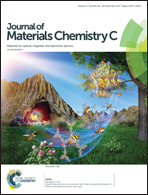Mercaptomethylphenyl-modified tetraphenylethene as a multifunctional luminophor: stimuli-responsive luminescence color switching and AIE-active chemdosimeter for sulfur mustard simulants†
Abstract
As a commonly known chemical warfare agent, sulfur mustard (SM) is a severe vesicant that can induce grievous blisters on the skin and mucous membranes. Because the onset of SM toxicity is fast, a rapid, sensitive, and accurate method for the detection of SM is necessary. However, designing an effective detection method for SM is challenging because SM does not have any traditional molecular recognition sites. In this study, a fluorescence probe for the detection of SM and an SM simulant (2-chloroethyl ethyl sulfide, CEES) was developed based on the reaction of benzenemethanethiol with the analytes. A non-emissive mercaptomethylphenyl-modified tetraphenylethene (TPE) probe was designed and synthesized. This probe can emit strong fluorescence upon reacting with CEES for 5 minutes in an aqueous solution in the presence of metal ions due to the formation of a sandwich-type complex, which can effectively restrict the rotation of the phenyl rings of TPE. Furthermore, this procedure exhibited high sensitivity for analytes and can be applied to the detection of CEES in soil. As a TPE derivative, this probe also exhibited a reversible solid-state luminescence color switching between blue emission (467 nm) in the crystal state and green emission (516 nm) in the amorphous state upon fuming, grinding and heating. These results indicate that S4 has potential as a multifunctional material of a “smart” luminophor and an AIE-active fluorescent probe for SM.



 Please wait while we load your content...
Please wait while we load your content...